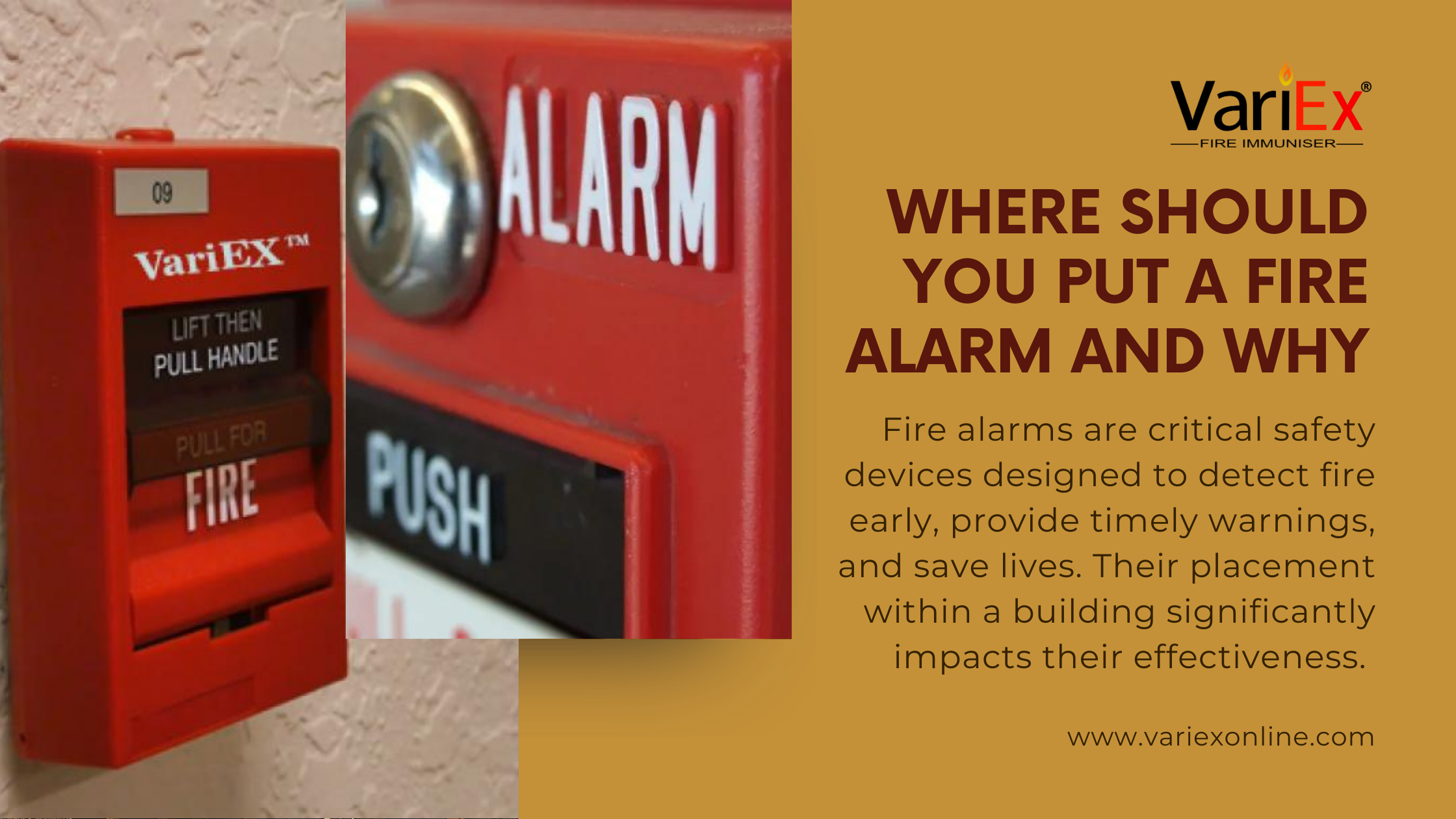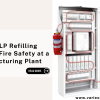![]()
Fire Immuniser
+91-7829629111
Email: info@variex.in
Varistor Technologies Pvt. Ltd.
Block-1, First Floor, Ardente Office One, Hoodi Circle, ITPL Main Road, Bengaluru, Karnataka 560048, IN
Where Should You Put A Fire Alarm And Why
Where Should You Put A Fire Alarm And Why
Fire alarms are critical safety devices designed to detect fire early, provide timely warnings, and save lives. Their placement within a building significantly impacts their effectiveness. Properly positioned fire alarms ensure that occupants receive the earliest possible warning, allowing for a quick and safe evacuation. This comprehensive guide will explore where to place fire alarms and why strategic placement is crucial.
The Importance of Fire Alarm Placement
Fire alarm placement is governed by several key considerations, including the type of building, its layout, the presence of fire hazards, and legal requirements. Properly installed fire alarms:
- Maximize Detection Efficiency: Early detection is essential in minimizing damage and increasing the chances of safe evacuation.
- Comply with Legal Standards: Building codes and regulations mandate specific placements to ensure safety and legal compliance.
- Ensure Comprehensive Coverage: Adequate coverage means no area of the building is left unprotected, reducing the risk of undetected fires.
- Prevent Nuisance Alarms: Correct placement reduces false alarms, which can desensitize occupants to real threats and lead to complacency.
General Guidelines for Fire Alarm Placement
- Smoke Alarms in Every Sleeping Area: Install smoke alarms inside each bedroom, outside each sleeping area, and on every level of the home, including the basement. This ensures that all occupants are alerted, even if they are asleep.
- Placement in Hallways and Corridors: Install alarms in hallways and corridors, particularly those leading to bedrooms. This provides early warning as smoke travels through these areas.
- Stairwells: Place alarms at the top and bottom of stairwells. Smoke rises, and having alarms at both points ensures that smoke traveling up or down is detected quickly.
- Living Areas and Common Spaces: Install alarms in living rooms, dens, and other common areas. Fires often start in these places due to electrical equipment, cooking appliances, and heating systems.
- Kitchens: While not recommended directly in the kitchen due to false alarms from cooking, place alarms nearby, such as just outside the kitchen area. Use specialized heat detectors in the kitchen to avoid false alarms.
- Basements and Attics: Install alarms in basements and attics, especially if these areas are used for storage or contain electrical equipment that could pose a fire risk.
- Garages: Place alarms in garages, as they often house vehicles, fuel, and other combustible materials that can ignite.
Specific Considerations for Different Types of Buildings
Residential Buildings
- Single-Family Homes: Follow the general guidelines for bedrooms, hallways, living areas, basements, attics, and garages.
- Multi-Family Dwellings (Apartments, Condos): Install alarms in each unit as well as in common areas like hallways, stairwells, and shared basements.
Commercial Buildings
- Offices: Place alarms in individual offices, open workspaces, conference rooms, hallways, stairwells, kitchens, and break rooms.
- Retail Spaces: Install alarms throughout the sales floor, stockrooms, fitting rooms, employee areas, and near entrances and exits.
- Industrial Facilities: Position alarms in production areas, warehouses, storage areas, break rooms, and offices within the facility.
Educational Institutions
- Schools and Universities: Install alarms in classrooms, hallways, common areas, laboratories, libraries, dormitories, and administrative offices.
- Daycare Centers: Place alarms in all rooms where children are present, including playrooms, sleeping areas, kitchens, and bathrooms.
Healthcare Facilities
- Hospitals and Clinics: Position alarms in patient rooms, corridors, waiting areas, operating rooms, laboratories, and administrative areas.
- Nursing Homes and Assisted Living Facilities: Install alarms in resident rooms, common areas, dining rooms, kitchens, and hallways.
Legal and Regulatory Requirements
Fire alarm placement is regulated by various codes and standards, including:
- National Fire Protection Association (NFPA) Standards: NFPA 72 outlines the National Fire Alarm and Signaling Code, which provides comprehensive guidelines for fire alarm installation, including placement, maintenance, and testing.
- International Building Code (IBC): The IBC sets requirements for fire alarm systems in new and existing buildings, specifying where alarms should be installed based on building type and use.
- Local Building Codes: Local jurisdictions may have additional requirements and modifications to national standards, so it’s essential to consult local building codes.
- Occupational Safety and Health Administration (OSHA): OSHA regulations may also influence fire alarm placement, particularly in workplace environments.
Factors Influencing Fire Alarm Placement
- Building Layout: Complex layouts with many rooms and corridors require strategic alarm placement to ensure comprehensive coverage.
- Fire Hazard Areas: Kitchens, garages, and areas with heavy electrical equipment or combustible materials need more focused alarm placement.
- Ventilation Systems: HVAC systems can affect smoke movement, so alarms should be placed to account for airflow patterns that might disperse smoke.
- Occupant Density: Areas with high occupancy, such as theaters, conference halls, and auditoriums, need more alarms to ensure early detection.
- Accessibility: Alarms must be accessible for regular testing and maintenance, following manufacturer guidelines and regulatory requirements.
Best Practices for Fire Alarm Placement
- Ceiling Placement: Smoke alarms should be placed on the ceiling or high on the wall, as smoke rises. Ceiling-mounted alarms should be at least 4 inches from the wall, while wall-mounted alarms should be 4 to 12 inches from the ceiling.
- Avoiding Obstructions: Ensure that alarms are not obstructed by furniture, curtains, or decorations, which can impede smoke entry and detection.
- Distance from Appliances: Avoid placing alarms too close to kitchens, bathrooms, or heating appliances to prevent false alarms. A distance of at least 10 feet is recommended.
- Interconnected Alarms: In multi-level buildings or large homes, interconnected alarms ensure that when one alarm is triggered, all alarms sound, providing comprehensive warnings throughout the building.
- Regular Maintenance: Test alarms monthly, replace batteries at least once a year, and replace the entire unit every 10 years to ensure reliability.
Advanced Fire Detection Technologies
- Photoelectric Smoke Alarms: Best for detecting smoldering fires with larger smoke particles, typically used in living areas and bedrooms.
- Ionization Smoke Alarms: More responsive to flaming fires with smaller smoke particles, often used in kitchens and bathrooms.
- Combination Alarms: These units combine photoelectric and ionization technologies, providing broader detection capabilities.
- Heat Detectors: Ideal for areas where smoke alarms may cause false alarms, such as kitchens and garages, as they detect rapid temperature increases rather than smoke.
Case Studies and Real-Life Examples
- Residential Fire Incident: A fire in a two-story home was quickly detected by strategically placed alarms in the hallway and bedrooms. The early warning allowed all family members to evacuate safely before the fire spread.
- Office Building Fire: In an office complex, a fire started in an electrical room. Alarms in the hallway outside the room provided immediate warning, enabling the fire department to respond quickly and contain the fire to one area.
- School Fire Drill: A school conducted a fire drill, testing alarms in classrooms, hallways, and common areas. The drill highlighted the importance of proper alarm placement in ensuring a swift and orderly evacuation of students and staff.
Conclusion
The strategic placement of fire alarms is critical to the safety of any building and its occupants. By understanding where to place fire alarms and why, you can ensure early detection of fires, compliance with legal standards, and comprehensive protection. Regular maintenance and adherence to best practices further enhance the effectiveness of fire alarm systems, providing peace of mind and safeguarding lives and property.
Frequently Asked Questions
Fire alarms should be placed inside each bedroom, outside each sleeping area, and on every level of the home, including the basement. They should also be installed in living rooms, hallways, stairwells, and near kitchens (but not directly in them).
Hallways and stairwells are primary paths for smoke to travel. Placing fire alarms in these areas ensures that smoke is detected quickly, providing early warnings and safe evacuation routes for occupants.
Yes, fire alarms should be installed in each unit, including inside and outside of each sleeping area. Additionally, common areas like hallways, stairwells, and shared basements should also have fire alarms to ensure comprehensive coverage.
In commercial buildings, fire alarms should be placed in individual offices, open workspaces, conference rooms, hallways, stairwells, kitchens, and break rooms. Placement should ensure all areas are covered and comply with local building codes and standards.
Fire alarms should not be placed directly in kitchens due to the likelihood of false alarms from cooking. Instead, place them nearby, such as just outside the kitchen area. Consider using specialized heat detectors in the kitchen to avoid false alarms while still providing protection.
Final Say
At VariEx.in and VariexOnline.com, we specialize in supplying and installing top-quality fire fighting systems and equipment. From fire extinguishers to advanced suppression systems, we offer comprehensive solutions tailored to your needs. Our experienced team ensures precise installation and maintenance for optimal safety.
Trust VariEx for reliable fire protection. Contact us online or call 7829629111 to learn more.
We specialize in manufacturing, supplying, and distributing a comprehensive range of fire fighting equipment, including state-of-the-art fire extinguishers. Read our most searched blogs and find interesting information on topics such as how to use a fire extinguisher, how to calculate fire fighting water tank capacity, fire extinguisher refilling, obtaining a Fire NOC, understanding fire fighting systems, types of fire protection systems, the fire hydrant system, and the fire sprinkler system. These resources provide essential knowledge for ensuring safety and compliance with fire safety regulations. Additionally, you can explore guides on the maintenance of fire protection equipment, the latest advancements in fire safety technology, and best practices for fire risk assessment and management.
Our expertise extends to fire alarm systems, fire hydrant systems, and fire suppression systems, including fire sprinklers. Each product meets rigorous international standards for reliability and performance, ensuring effective fire safety products tailored to diverse applications and industries. Additionally, we are providing Fire Extinguisher Refilling and AMC services to ensure ongoing maintenance and operational readiness of fire safety equipment.











